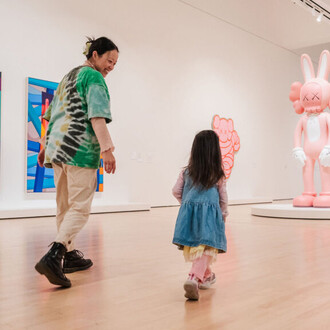Glass Rice is proud to present Do You See This Too?, a group exhibition featuring paintings by Arika von Edler, Christopher Tandy and Felicita Norris, sculptures by Michael Koehle, and drawings by Peter Rajani. Oftentimes what an individual may perceive as reality may not be visualized by the next. Humans consistently seek out reassurance, a connection, and a tie to another, naturally wanting to be a part of a bigger picture, a greater whole, and a community. Within each perceptual connection lies a conduit to a greater idea or collective thought. In Do You See This Too?, audiences are urged to travel down an introspective route and to question what is before them by taking their time with each piece to reveal personal and collective narratives.
Arika von Edler's oil paintings probe questions about abortion, slut-shaming, rape, maternity, birth control, queerness in relation to femininity, and overall reproductive feminism. By borrowing from her own experiences, she uses her paintings as a vehicle to reflect on these present-day struggles and our culture’s attitude towards these topics, simultaneously making her work both diaristic and an attempt to speak on issues plaguing our communities today.
Through careful abstractions of portraits and figures framed by pure, white space, Christopher Tandy explores the murky waters of the collective unconscious, the human condition, and human emotion through isolating these sexually ambiguous, non-descript figures. While remaining focused on the deepest recesses of the human mind, Tandy addresses aspects of identity, sexuality, and gender by obscuring key elements such as facial features and genitalia, two indicators our society readily associates with these concepts. His technique reflects just how dark and cloudy it can be to tap into and explore these topics with smudges of charcoal and graphite worked into the multilayered depths of watercolor. Through this process, Tandy is able to create a universal mirror, reflecting back to his viewers not a recognizable figure, but rather a skeletal version of themselves, broken down to its very core.
Felictia Norris creates large-scale paintings that are reactions to personal experiences. Though the images and themes represented are not strictly autobiographical, Norris creates a confined stage to depict unsettling images that are responses to social constructions, institutions, and politics. By creating scenes set in familiar environments such as bedrooms, bathrooms, and living rooms, she uses comforting, home-y settings to reveal the complexities of "the familiar," evoking emotion by way of symbology and metaphor, and using the human figure and noxious color to draw the viewer inward to recognize that these issues hit closer to home than one would imagine.
Michael Koehle invents methods of art making with paper, paint, oil, aluminum, laser cutting, and CNC machining to look at a subject in varying ways, each individual experience slightly different than the experience before or after. Much of his work depends on where a viewer is standing to determine how they will visually interact with the work. “I believe the more ways you look at something, the more you can learn about it. I also believe that you can never really know something.” This idea shapes Koehle’s work into conditional experiences to help viewers recognize that their own observations are contingent and limited. Peter Rajani’s work deals with the production, distribution, and consumption of drugs as commodities and their relationship to narratives of erotic abandon, loneliness, and excess. Rajani’s finely detailed drawings confront these intimate themes of sex, drug addiction and dissemination through provocative, yet familiar imagery. Viewers are forced to come face to face with the underlying results that come from a society saturated by the “glamor” and glorification of drug use.
















